How to Read a Korean Menu // Tips and Tricks With Popular Dishes and Key Words
How to Read a Korean Menu
When you’re visiting another country, the first thing you want to do is try out the food. So today we are going to teach you how to read a Korean menu!
This is the chance to experience new and exciting culinary sensations you wouldn’t get back home.

Korea is no such exception, offering a diverse selection of wonderful foods, from Buddhist vegetarian dishes to crunchy fried chicken, with restaurants catering to every possible taste.
However, there can be some difficulties in actually ordering the food.
In Korean restaurants, you can’t always expect a menu to have an English translation.
Sometimes there is; sometimes there isn’t. A complete newbie might be handed a menu in Korean without any pictures for guidance.
For those of you who see yourselves in this scenario, here are some tips on how to read a menu at a Korean restaurant.
Reading a Menu in Korean | How to say “menu”
Reading a Menu in Korean | Rice
Reading a Menu in Korean | Soups & Stews
Reading a Menu in Korean | Noodles
Reading a Menu in Korean | Options & Extras
Reading a Menu in Korean | Common Drinks
Reading a Menu in Korean | More Vocabulary
Reading a Menu in Korean | Time to Order!
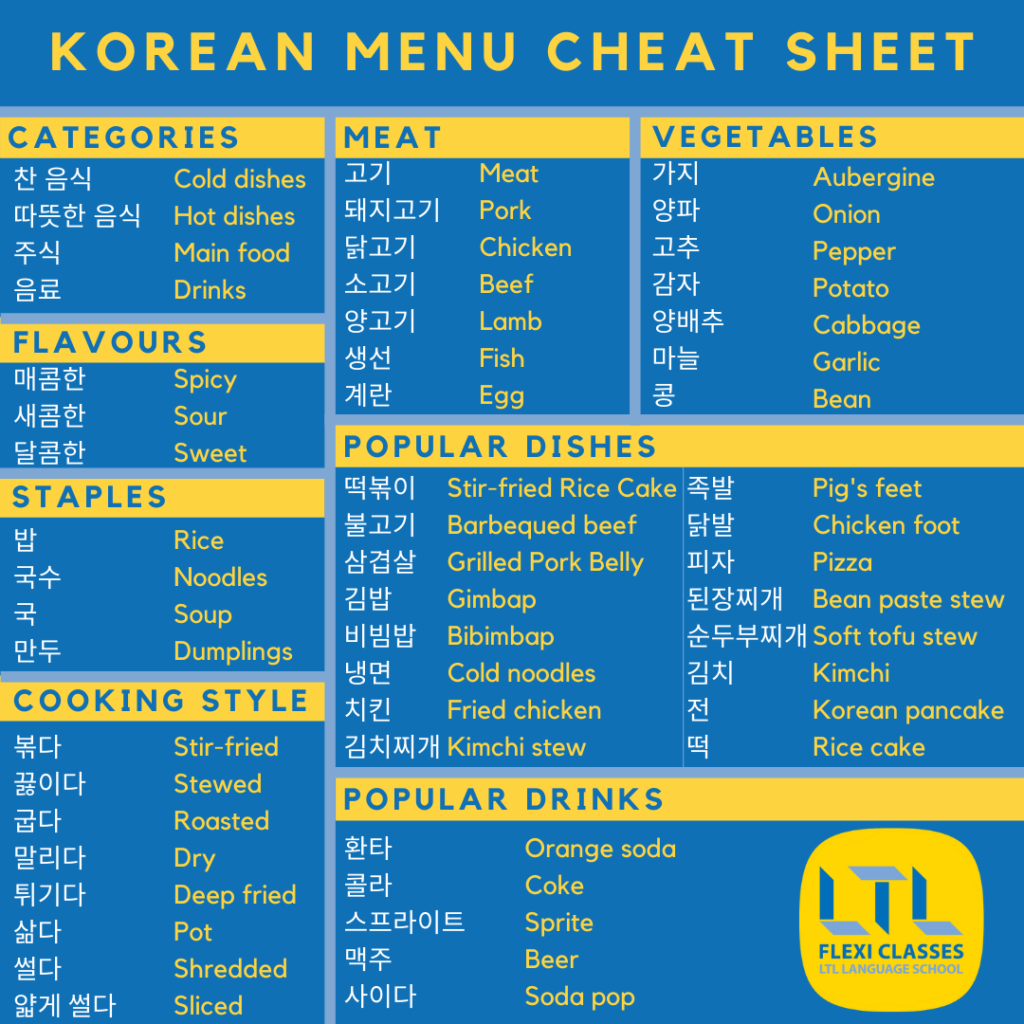
How to Say Menu in Korean
How do you even say the word “menu” in Korean?
It might surprise you, but the answer is 메뉴 (menu).
Nowadays, most Koreans use the English word 메뉴 (menu) instead of original Korean words like 차림표 (charimpyo) or 식사류 (shiksaryu), though the latter words do show up occasionally.
This makes it easy for native English speakers. When you go to a restaurant, all you have to do is ask for the 메뉴 (menu) or 메뉴판 (menupan).
👉 메뉴판 (menupan) is more precise because adding 판/pan at the end of a word turns it into a flat object like a board or panel.
So 메뉴판 (menupan) makes it clear you’re asking for the physical menu, instead of asking what’s on the menu.
Let’s now see how to read a Korean menu!
How to Read for Rice on Korean Menus
Unsurprisingly, rice is one of the most commonly offered selections on a Korean menu.
In Korean, cooked rice is referred to as 밥 (bap).

When you see a word ending in 밥 (bap), you can safely assume it’s some sort of rice dish.
For example, 덮밥 (deopbap) is a rice dish that’s topped with other foods, ranging from chicken and eggs to vegetables.
비빔밥 (bibimbap) is a dish of rice mixed together with vegetables, a bit of protein, and sauce for flavouring.
볶음밥 (bokkeumbap) literally means fried rice.
Most restaurants offer plain white rice, which comes in small steel bowls with covered lids. This is called 공기밥 (gonggibap).
Some restaurants even give free servings of 공기밥 (gonggibap) to go with the main meal.
Soups and Stews on Korean Menus
What’s the difference between soups and stews in Korea? Like in other cultures, stews are usually just a thicker, heartier version of soups.
In Korean, soup is referred to as 국 (guk).
On a menu, any word that ends in 국 (guk) is usually a type of soup. For example, 된장국 (doenjangguk) means “soybean paste soup,” and it’s a common option in Korean restaurants.
However, there’s another common ending for soup-related words. That word is 탕 (tang). If you see a word ending in 탕 (tang) on a Korean menu, then it’s a soup.
DID YOU KNOW | tāng (汤) is also soup in Mandarin Chinese!
Popular soup-based Korean dishes include 설렁탕 (seollantang), which is an ox bone soup, and 삼계탕 (samgyetang), a ginseng chicken soup.
In Korean, stews are called 찌개 (jjigae).
Korea offers a wide variety of popular stews, so you’re bound to encounter some on a trip to Korea. Look for words on a menu that ends in 찌개 (jjigae).
You can go for soybean paste stew, which is heartier and thicker than the soup version listed above – just ask for 된장찌개 (doenjang jjigae).
Another highly recommended dish is soft tofu stew, which is called 순두부 찌개 (soondubu jjigae).

The Best Korean Food 🇰🇷 The Top 10 Korean Dishes for New Eaters to Try Out
There’s LOTS of various dishes in the Korean gastronomy. It might be hard to know what to try out first, so we selected the best Korean food for you to try.
Noodles on Korean Menus
In Korean, there are two words for noodles – 국수 (guksu) and 면 (myeon).
On a Korean menu, if you see any dish containing either of these words, you’re probably looking at a delicious noodle dish.
There are many types of Korean noodles.
- 비빔국수 (bibimguksu) refers to spicy wheat flour noodles, usually served cold.
- 칼국수 (kalguksu) is a hot mildly-flavoured soup with knife-cut noodles.
- 냉면 (naengmyeon) is a cold soup with buckwheat noodles, originating from North Korea.
- 쫄면 (jjolmyeon) is a spicy, starchy noodle dish that is known for being very chewy.
Try it out sometime!
Adding More Options & Getting Extras
추가 (chuga) is one of the most important words to know at a Korean restaurant. It simply means “add.”
If you look at menu, you might see some special 추가 (chuga) options.
It usually means an extra flavour, dressing, or portion thrown into the regular meal. For example, cheese is a popular add-on to certain meat dishes in Korea.
If you see 치즈추가 (cheese chuga), that means you can get the cheese melted into your chicken or pork.
You can also ask the waiter or waitress for another serving of your food by using this word. Simply state the name of the food, indicate the number of portions, and say 추가하세요 (chugahaseyo).
You’re literally just asking to add another serving!
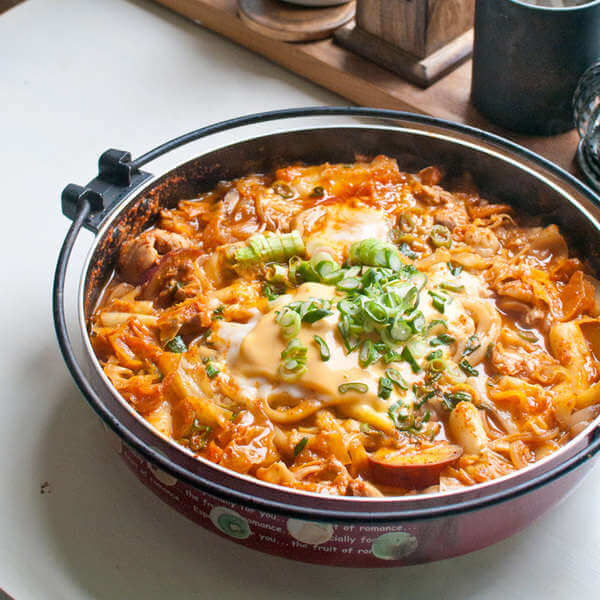
Common Drinks in Korean Restaurants
Flip to the end of a Korean menu, and there’s often a list of drinks. While water is usually provided for free, you’ll have to pay a few extra won for a soda or alcoholic beverage.
Look for a section called 음료 (eumnyo) or 음료수 (eumnyosu).
Both words mean “beverages,” but they often refer just to soda.
The type of 음료수 (eumnyosu) offered at most restaurants are 콜라 (cola) and 사이다 (saida).
콜라 (cola) refers to dark sodas such as Coca-Cola, while 사이다 (saida) refers solely to lemon-lime sodas.
There might be another section in the menu called 주류 (juryu), which means alcohol.
The most common types of 주류 (juryu) are soju and beer.
소주 (soju) is a strong Korean drink that’s famously cheap and accessible. Beer in Korean is called 맥주 (maekju), and it’s probably the second most accessible drink.
Don’t forget to check out our guide to Korean Drinking Culture! 🍻
Often, shorter menus don’t have a clear dividing section between 음료 (eumnyo) and 주류 (juryu), simply putting all the drinks together.
So be aware of what you’re getting – you don’t want to order an alcoholic drink by accident!
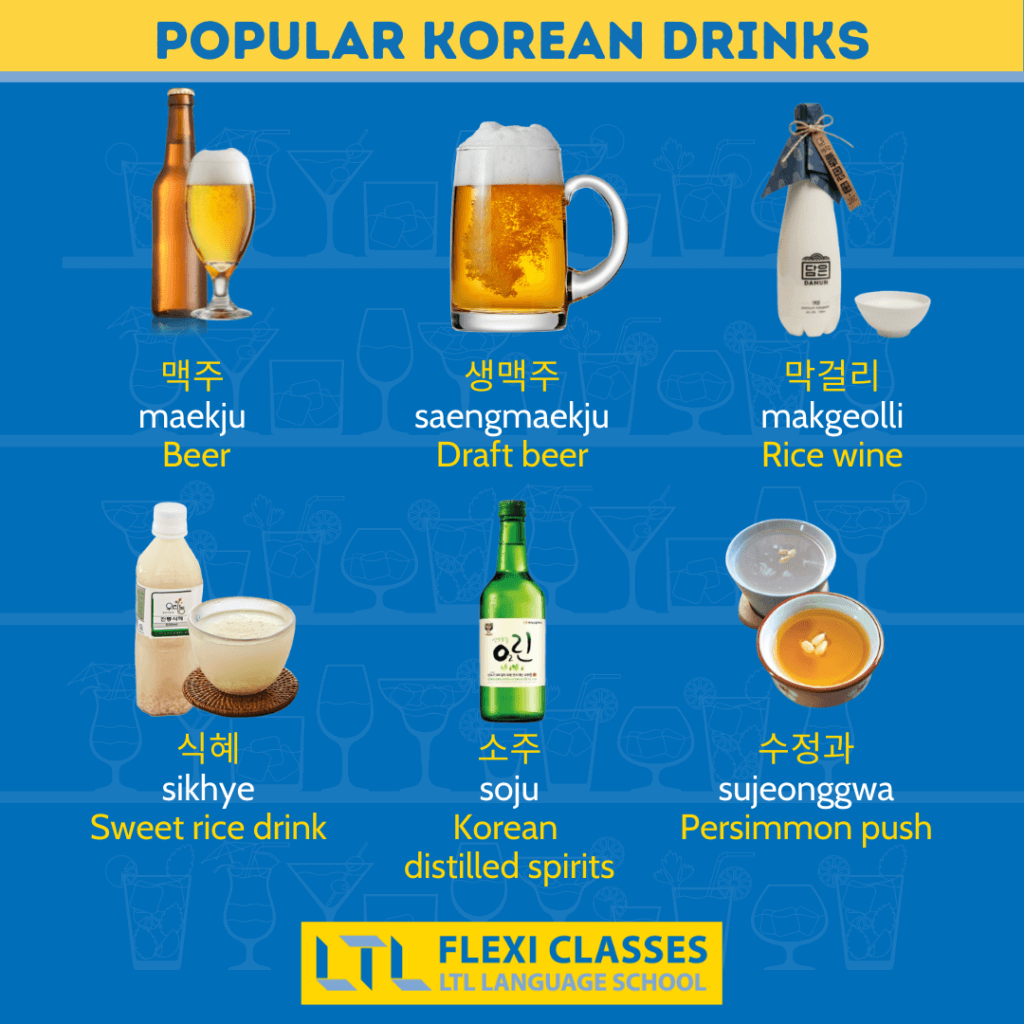
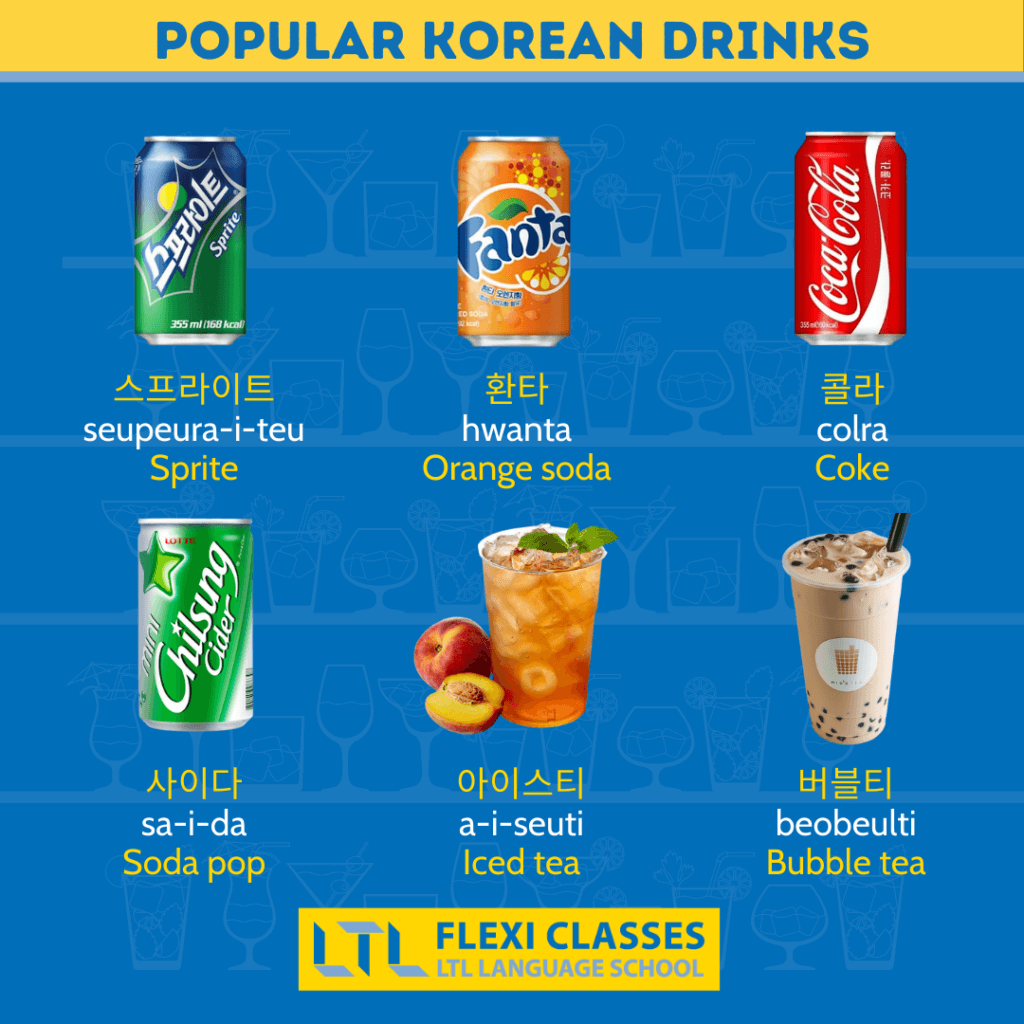
A Few More Important Words to Know
Here are a few more basic words to know – not just for Korean menus, but for Korean cuisine in general.
반찬 (banchan) refers to side dishes – anything that is not the main dish or rice.
Most Korean restaurants give out 반찬 (banchan) for free along with the ordered meal. You’ll get small dishes of anything from potato salad to cubed radish to bean sprouts.
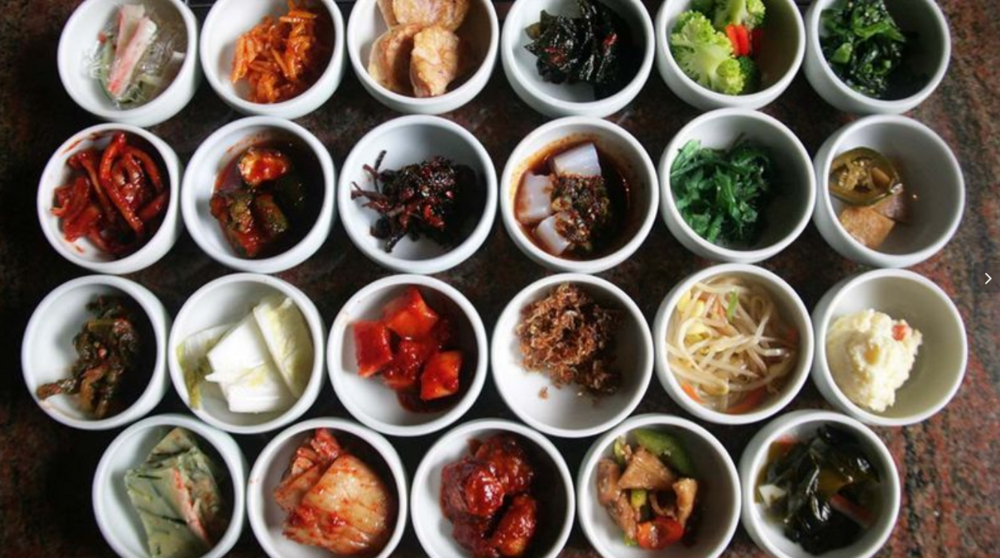
김치 (kimchi) refers to fermented vegetable dishes.
While there are hundreds of different types of kimchi, the most common form is cabbage preserved with chilli peppers. You’re guaranteed to get this, along with a couple of other types of kimchi, at most Korean restaurants.
고기 (gogi) means meat. Depending on the menu, there might be a section just for the meat dishes.
However, there are many Korean dishes that contain meat products, even though they’re not considered meat dishes in themselves.
For example, a soup may be based on a beef or anchovy stock.
If you’re ever unsure, it’s always best to ask.

63 Korean Words You Never Knew You Knew!
Did you know you already know loads of Korean words and that’s thanks to the inclusion of Korean Loanwords in the language. Here’s our favourites.
Now It’s Time to Order
To review, here are the basic words to look for on a Korean menu:
| English | Korean |
|---|---|
| rice | 밥 (bap) |
| soup | 국 (guk) |
| soup | 탕 (tang) |
| stew | 찌개 (jjigae) |
| noodles | 국수 (guksu) |
| noodles | 면 (myeon) |
| meat | 고기 (gogi) |
| fermented vegetables | 김치 (kimchi) |
| soda | 음료 / 음료수 (eumnyo/eumnyosu) |
| alcoholic drinks | 주류 (juryu) |
| dark soda | 콜라 (cola) |
| lemon-lime soda | 사이다 (saida) |
| soju | 소주 (soju) |
| beer | 맥주 (maekju) |
Other important words to know in a Korean restaurant are listed below:
| English | Korean |
|---|---|
| menu | 메뉴판 (menupan) |
| sides dishes | 반찬 (banchan) |
| add | 추가 (chuga) |
With that, you now know how to read a Korean menu. Or at least easily navigate one!
You might not know every food, but you should know the gist of what you’re ordering and not be too surprised when your meal arrives.
Or you could be truly adventurous and just point randomly at something on the menu without even looking.
You’re bound to have an interesting experience!
Enjoy de-coding menus from different languages?
Why not also check out our guide on reading a Chinese menu, there are some cross-over words with Korean interestingly enough.
HOW TO READ A KOREAN MENU – FAQ’s
How to say Menu in Korean?
Menu in Korean is 메뉴 (menu).
How to say Drinks in Korean?
Drinks in Korean is 음료 (eumnyo) or 음료수 (eumnyosu).
How to say Rice in Korean?
Rice in Korean is 밥 (bap).
How to say Noodles in Korean?
Noodles in Korean is 국수 (guksu) and 면 (myeon).
How to say Soups and Stews in Korean?
Soup in Korean is 국 (guk).
Stew in Korean is 찌개 (jjigae).
What are some of the best Korean dishes?
The Korean food culture is RICH.
Some of the best dishes for new eaters to try out are Kimchi Stew, Soft Tofu Stew, Spicy Rice Cake, Mixed Rice Bowl, Seafood Pancake, and Cold Noodles.
Want More From LTL?
FANCY LEARNING KOREAN? Check out our online Korean courses here.
We offer a 7-day free trial to all online students where you can study Korean 24/7.
Want to study Korean in Korea instead? Our Korean courses in Seoul can either be taken in small groups of no more than 5 students or individually for a more tailored experience.
We even offer incredible homestay experiences in Seoul too.
To top it all off, it certainly doesn’t end with Korean. Check out the other languages we teach 👇🏻











1 comments
[…] you enjoy this kind of content why not also check out our guide on learning how to read a Korean menu as […]